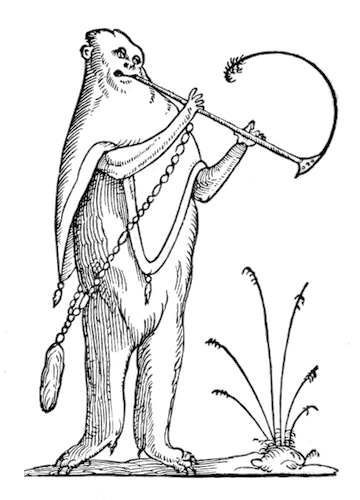
Bedded Bugs and Stung Beetles: The Cameraman’s Revenge (1912)
Mr. Beetle is bored in his marriage. After work, to which he commutes by motorcar, he decides to visit the Gay Dragonfly nightclub, as business bugs are wont to do. “The dancer there understood him.” She is indeed beautiful, a leggy Odonata, who is pursued, after her erotic gyrations, by both the stag beetle and a brash grasshopper, “a movie cameraman”. The former insect wins her buzzing affections, and they elope to a love hotel, but the grasshopper follows on bicycle with his camera in tow. He records their lovemaking through a keyhole and rides off to exact revenge. Meanwhile Mrs. Beetle’s antennae have not been idle. She sends a missive to her artist-beetle lover. “He is away — I am alone — Come!” And he does. They begin to intertwine their many legs, but Mr. Beetle arrives home unexpectedly, and the artist attempts to escape through the chimney, leaving behind a canvas. Domestic violence ensues as Mr. Beetle breaks the inamorato’s artwork over his poor wife’s head and drives her lover into the dirt. Later, the husband and wife attend the cinema — an enduring fantasy space of escape for the unhappily married — whose projectionist is none other than the vengeful grasshopper. As the opening credits roll, Mr. Beetle has a horrifying realization: he has come to immerse himself in fiction but is forced to watch his own infidelity on screen. More domestic violence ensues. Mr. and Mrs. Beetle end up in jail. The film ends with an intertitle: “The home life of the Beetles will be less exciting in the future, we hope.”
This may sound like a hand-drawn animation of entomological adultery — an after-the-watershed Bug’s Life — but The Cameraman’s Revenge (1912) is actually a painstaking stop-motion film, featuring real insect corpses, carefully arranged by the nimble hands of Ladislas Starevich (1882–1965). Born to Polish parents in Moscow, Starevich studied visual art before becoming director of the Museum of Natural History in Kaunas, Lithuania. Here he saw his opportunity. After failing to record live stag beetles warring — they froze with stage fright before the heat-emitting spotlights — he pivoted toward dead bugs. “I came up with the idea of putting my little knights to sleep. I separated their legs and jaws from their abdomens, and then put them back in place with the help of thin wires. This way I could dress the beetles in costumes, knee-high boots, and put swords in their hands.” His Beautiful Leukanida (1912), another beetle biopic, is sometimes cited as the first work of puppet animation. He made nearly one hundred films across fifty years (many lost), a feat especially unfathomable given the labor necessary to choreograph his actors’ delicate wings and claws: at his most productive, he was only able to shoot six minutes of footage per month. When his stop-motion films first premiered, critics did not quite know what they were seeing. Some reviewers believed that he had trained a real-life flea circus for his troop.
Beetles have long been unexpected artistic collaborators. Their carapaces once illuminated Basohli miniatures; their lettered bark has inspired bibliographic art projects and poetic works of conceptual translation. They have been symbolic fodder in illuminated manuscripts and Sisyphean workhorses in entomological memoirs. And yet, before Starevich’s innovation, they had never played leading men and women on the silver screen. But Starevich’s films are significant and cannot be reduced to mere gag or novelty. Here, one of cinema’s most psychologically complex themes — the erotic voyeurism and scopic violence of the medium itself — receives sustained, attentive thought. Rear Window, Peeping Tom, Blow-Up, Cache: these films are better known, but they owe a debt to The Cameraman’s Revenge.
For more on early Russian animation, see Noah Sneider’s article “The Forgotten Ephemera of Genius” in The Believer.
Enjoyed this piece? We need your help to keep publishing.
The PDR is a non-profit project kept alive by reader donations – no ads, no paywalls, just the generosity of our community. It’s a really exciting model, but we need your help to keep it thriving. Visit our support page to become a Friend and receive our themed postcard packs. Or give a one-off donation. Already a supporter? A huge thank you for making all this possible.
Mar 26, 2025





